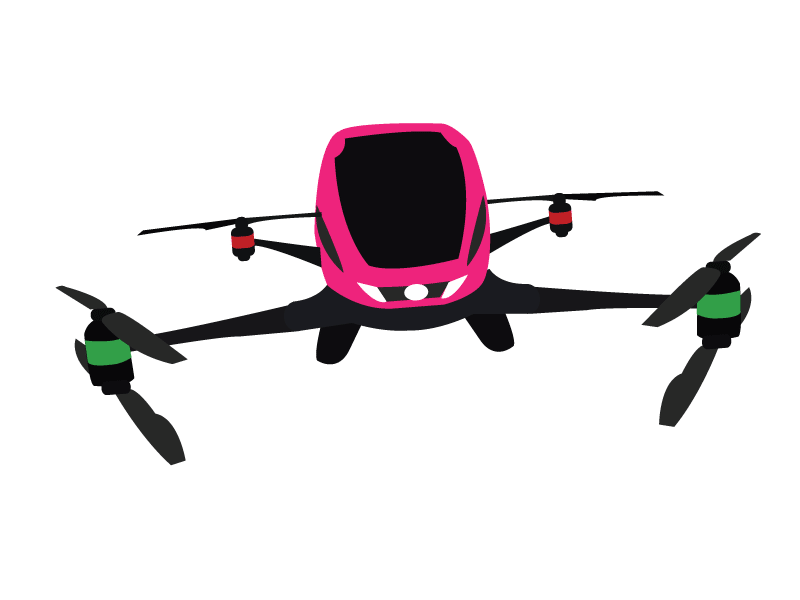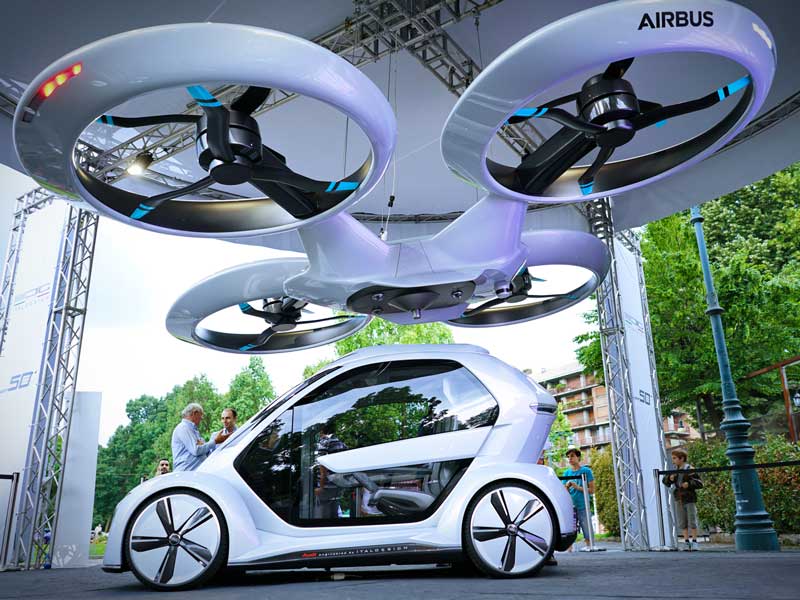Flying cars are the stuff of science fiction. Futuristic cities where citizens commute in personal aircraft are the domain of the Jetsons or Star Wars. Predictions of personalised air transport have been around for decades, but safety, cost, and engineering feasibility have stood in the way of these ventures in the past.
Recently, however, renewed interest in personal air transport has gained traction. Advances in energy storage, composites manufacturing, and computer-assisted flight make small-scale aviation seem increasingly feasible, perhaps even likely. Chief amongst this new crop of personal aviation ideas are electric vertical takeoff and landing (eVTOL) vehicles.
eVTOLs sit between drones and helicopters in terms of capabilities. They replace a helicopter’s engine and rotors with many battery-powered electric motors that turn smaller rotors. However, they’re much bigger than most drones, and most prototypes include space for 2-4 passengers. The idea is for these electric vehicles to take to the skies to deliver passengers on short trips around densely populated areas. A trip that may have taken a long time due to traffic or geography could be drastically reduced by simply flying.
The History of Urban Air Transport
Of course, eVTOLs aren’t the first vehicles capable of transporting air passengers over short distances. Helicopters have been around for decades. If urban air transport is such a good idea, one argument goes, we should all be cruising around our cities in helicopters by now.
From 1949 to 1979 an urban helicopter airline did exist in New York City. New York Airways carried passengers between the city’s major airports and surrounding towns as well as operating flights from the top of the Pan Am building in Midtown Manhattan. However, a series of fatal accidents in the late 70s led to the closure of the Pan Am heliport and eventual bankruptcy of the airline.
Aside from the safety concerns, helicopters also come with quite a bit of noise and a high price tag to operate and maintain. eVTOL proponents argue that their solution is far superior for small-scale transport applications. For starters, eVTOL models usually include four, eight, or even more rotors spaced around the aircraft. Unlike with a helicopter, if one component were to fail, it wouldn’t mean imminent danger.
Additionally, because
The Technical Challenges of eVTOL
Despite the advantages and clear potential of eVTOL vehicles, there are still many challenges on the road to a future where we fly around our cities. The first and biggest technical challenge is energy density. Fossil fuel hydrocarbons release a lot of energy per gramme of mass they add to the vehicle weight. Our best batteries are much less efficient at storing electrical energy. As a result, current eVTOL models have a relatively short range due to the mass of the batteries they need to carry on board. More efficient batteries are the first major challenge to making eVTOL flight more feasible and usable across longer ranges.
In the absence of a breakthrough on batteries, eVTOL researchers are relying on advanced composite manufacturing methods to lighten the weight of their vehicles whilst still maintaining strength. This is still a relatively new area of manufacturing. There are a lot of kinks to be worked out in order to consistently produce safety-tested components on a large scale.
Designs for eVTOL vehicles are still unfinalized as well. These vehicles won’t look like helicopters, but it’s not clear yet what is the ideal configuration of rotors and passenger cabin. Some companies are experimenting with vertical takeoff vehicles that can then transition to fixed-wing forward flight once airborne, a more efficient option for longer distances. Other companies are prioritising more reliable and easier to design rotary wing flight.

Investment Floodgates are Open
The good news is there’s no shortage of investments and competition in the eVTOL industry. Aviation News International reports over $1 billion has been invested in the space. The market opportunity is enormous for anyone who can devise a new, more efficient means of urban transit. Major industry players like Boeing and Airbus are working on their own designs. However, the race is led by a pack of hungry startups competing to be the first to market.
Google’s Larry Page is backing Kitty Hawk’s solution, who along with Joby Aviation recently received funding from the U.S. Department of Defence. Germany-based Volocopter recently flew their VC200 model across the stage at CES, flew their first manned flight in 2016, and have been working hard on the prototype in collaboration with Intel. Uber has its own plans for flying taxis, including working with Aurora Flight Sciences, now a subsidiary of Boeing on an air taxi service that Uber claims will take its first passengers in 2023. That estimate seems very optimistic and probably unlikely, according to many experts once you take regulations, permitting, and other challenges into account.

What Does an eVTOL Future Look Like?
One thing is clear: you probably won’t drive an eVTOL vehicle. Trained pilots will fly the first flights in these new models, including the first commercial flights. However, with a pilot shortage already projected in the conventional airline industry, the pressure is on for autonomy in eVTOL vehicles. Autonomy in the air comes with a myriad of challenges not seen in driverless vehicles. For one thing, there are no roads or clear paths in the sky. Autonomous aircraft will have to make their own decisions about how to get from A to B safely. Additionally, there are all kinds of challenges with context and environmental factors that make airborne autonomy especially tricky.
Such a future will require breakthroughs in other technologies outside of aeronautical engineering. Navigation will use technologies like GPS to take you from one heliport to another, likely using an app like Uber. However, autonomous eVTOLs will also need to know where other airborne vehicles are in real time, making the emerging field of vehicle-to-vehicle communication a necessity in the sky. Any pilotless vehicle will, of course, rely heavily on sensors to navigate and avoid obstacles, but in the sky, those sensors need to work inside of clouds and in any weather conditions. Advances in LIDAR and other sensor technology will play an important role, as will emerging research in computer vision and deep learning to make navigation decisions in 3D space.
Other applications for eVTOLs besides urban mobility include shorter flights between nearby small cities. These flights aren’t currently commercially viable for large jets, but small town airports could see a revival if short-haul flights become the domain on eVTOLs. Additionally, Boeing is testing the cargo capabilities of eVTOLs, including a recent test where a vehicle developed in three months successfully flew 225 kgs of cargo.
Next Steps
Urban air transport technology is nearly there. Today’s prototypes are remarkably close to solving many of the early challenges. With breakthroughs in batteries and manufacturing materials, expect these vehicles to only become more efficient. However, the timeline to the average person taking an air taxi is still removed. Even with a finalised design, vehicles will need years of safety testing and regulatory permissions processes before customers will be allowed to ride in them. It will also require an economy of scale for the cost of manufacturing to come down to reasonable levels. Electric flight may be a luxury for the rich before it becomes affordable to the masses, but if development continues at its current pace, we shouldn’t have to wait too long.
Fancy working for one of these companies? I am currently working with a
View these latest jobs:
Real Time Embedded Software Engineer
If you have enjoyed this article, please consider signing up to receive our monthly newsletter below which includes our latest articles, jobs and industry news.
View our latest selection of jobs
Get our latest articles and insight straight to your inbox
Hiring Machine Learning Talent?
We engage exceptional humans for companies powered by AI
